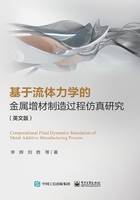
3.3 Simulation results and discussion
In this section,the results of the model with the fluid stabilizing cover will be compared with the results of the model without the fluid stabilizing cover,which can reflect the influence of the fluid stabilizing cover on the flow field in the cavity and the effect on the particle removal effect. Particle initial velocity was adjusted to research the impacts on the number of particles re-deposited on the workbench. In order to more intuitively reflect the particle removal effect in each situation,a“removing rate” is used in this section and defined as follows

where R is the removing rate,Nd is the number of particles re-deposited on the workbench and Nt is the total number of counted particles.
3.3.1 Influence of the fluid stabilizing cover on the flow field
In order to study the change of the flow field after using the fluid stabilizing cover,first simulate the flow field without the fluid stabilizing cover as a comparison. Calculate from the introduction of 4 m/s shielding gas until the flow field in the area above the workbench is stable enough. Through simulation,it is found that by 3.0 s,the flow field in the area above the workbench is stable enough.Then intercept the flow field diagram at a specific section for comparative analysis to observe the changes in the flow field.
Fig. 3-5 shows the flow field horizontal distribution characteristics of different height sections from the workbench. As shown in Fig. 3-5(a),at the height of 8 mm from the workbench,the flow field in the central area of the workbench of the two models is very uniform. But the difference is that the flow field direction of the model without fluid stabilizing cover near the two sides of the workbench has a large degree of deflection,while in the model with the fluid stabilizing cover,the flow field deflection near the two sides of the workbench is greatly reduced.

Fig. 3-5 Horizontal distribution characteristics of flow fields in two models
Distance to workbench: (a) 8 mm,(b) 18 mm,(c) 28 mm

Fig. 3-5 Horizontal distribution characteristics of flow fields in two models Distance to workbench: (a) 8 mm,(b) 18 mm,(c) 28 mm(successive)
The difference in the flow field shown in Fig. 3-5(b) is the biggest. In the model without the fluid stabilizing cover,the offset of the flow field near the two sides at a distance of 18 mm above the workbench is large,and even a local vortex field is generated. After using the fluid stabilizing cover,the flow field becomes more uniform and stable.
In Fig. 3-5(c),the flow field of the model without the fluid stabilizing cover is relatively turbulent at a distance of 28 mm from the workbench,and a vortex field appears,and the shielding gas velocity is very low in some places. After using the fluid stabilizing cover,the shielding gas becomes more stable,and the gas velocity in the area has also been improved.
Fig. 3-6 shows vertical distribution of flow fields in two models. Fig. 3-6(a)shows the flow field in the cross-section perpendicular to the center of the workbench and parallel to the X axis in the two models. Fig. 3-6(b) shows the laminar flow height in the central area above the workbench. In the model without the fluid stabilizing cover,the laminar flow height is 30 mm. After using the fluid stabilizing cover,the laminar flow height is increased to 40 mm,with an increase of 33.3%.

Fig. 3-6 Vertical distribution of flow fields in the two models

Fig. 3-6 Vertical distribution of flow fields in the two models(successive)
In general,after using the fluid stabilizing cover,the flow field in the area above the workbench becomes more stable,and the laminar flow height is also increased,which will be more conducive to improved the particle removing rate.
3.3.2 Influence of fluid stabilizing cover on particle distribution and removing rate
When the gas flow above the workbench is sufficiently stable,the particles will be released. The release process lasts for 0.5 s,and the total number of particles released is 4500. After the release is completed,continue the simulation calculation until all the particles are absorbed or blown out from the outlet. Then get the distribution map of the particles on the workbench,as shown in Fig. 3-7.
It can be seen from Fig. 3-7(a),Fig. 3-7(b),and Fig. 3-7(c) that the model without the fluid stabilizing cover has more particles re-deposited on the workbench,and the area of the workbench without adsorbed particles is small. After using the fluid stabilizing cover,the particles re-deposited on the workbench are significantly reduced,and the area without adsorbed particles is significantly increased,which will reduce the number of particles falling on the parts and improve the product quality.

Fig. 3-7 Distribution of particles on the workbench when initial speed is variable.Particle initial velocity: (a) 3 m/s,(b) 5 m/s,(c) 7m/s

Fig. 3-7 Distribution of particles on the workbench when initial speed is variable.Particle initial velocity: (a) 3 m/s,(b) 5 m/s,(c) 7m/s(successive)
Fig. 3-8 and Fig. 3-9 respectively show the number of particles adsorbed on the workbench and the removing rate of particles. After using the fluid stabilizing cover,the number of particles re-deposited on the workbench is reduced,and the removing rate is increased,even for particles with different initial velocities. For models without fluid stabilizing cover,the removing rates are 60.02%,63.91%,60.37%,when particle initial velocities are 3 m/s,5 m/s,7 m/s,respectively. For models that use a fluid stabilizing cover,the removing rates are 73.08%,73.04%,76.15%,when particle initial velocities are 3 m/s,5 m/s,7 m/s,respectively. This means that after using the fluid stabilizing cover,the removing rate of particles with different initial velocities can be increased,the number of particles falling on the parts can be reduced,and the product quality can be improved.

Fig. 3-8 Number of particles re-deposited on the workbench

Fig. 3-9 Particle removing rate of two models when particle initial speed changes